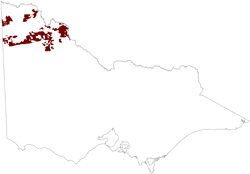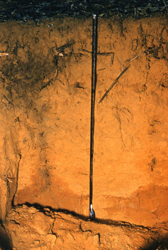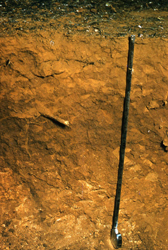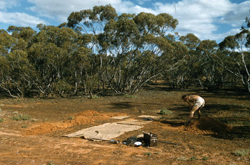5.1.2 Linear dunes co-dominant (north and east of Big Desert, south of Millewa)
5. North Western Dunefields and Plains (DP)
5.1 Calcareous dunefields
| East-west dunes occupy almost half of the regional depressions in the northern and central parts of the Mallee, associated with plains and occasional ridges. The unit occurs along the northern edge of the Sunset Country, in the central Mallee extending from the South Australian border through Ouyen to the River Murray between Nyah West and Boundary Bend. Boundaries are clear, except to units 5.1.1 and 5.1.3. Usual dune dimensions are width 100 metres, height 3-10 metres and length 1-3 kilometres. Dune crests are smooth and the southern slopes are relatively steep. original vegetation is mostly small mallee with spinifex understorey on the crests and mallee with a sparse ground layer on the lower slopes. Deep loose sands on the dunes are mostly reddish-yellow, sharply underlain by compact yellowish-red sandy loam to sandy clay loam. |  |
Interdune swales characteristically have medium-textured Calcarosols with red brown sandy loam to loam surfaces and yellowish-red subsoils with abundant carbonates. In places, visible carbonates extend to the surface which is grey-brown, locally referred to as “limey soil”. Shallow loams on limestone frequently occur in the west. The original swale vegetation is mostly mallee with sparse understorey.
Scattered areas, for example the Timberoo Reserve to the south-east of Walpeup originally carried woodlands of Pine Pine (Callitris preissii), Belah (Casuarina pauper) and Buloke (Allocasuarina luehmannii). . Red brown soils, both on dunes and swales, are highly regarded for agriculture.
At the lowest elevations there are outcrops of Blanchetown Clay with gilgaied grey clay soils. The associated Bungunnia Limestone is more widespread. It has mostly angular stones in beds a metre or more thick. The shallow, loamy soils are littered with limestone.
Most of the unit has been cleared for agriculture except the northernmost area in the Sunset Country. The dunes and swales have very different moisture and fertility regimes, posing problems in management. Erosion has been particularly severe on the dunes, sometimes exposing the hard cores. Drift sand accumulates on the flanks of the dunes and to the east of obstructions such as fences and remnant trees. The extent of erosion has been greatly reduced by maintaining cover of crop, stubble or pasture. The development of saline seeps in swales is also a problem.
 Sandy Calcarosol on upper slope of linear dune near Ouyen. Compact layer below 1 M is the remnant of an eroded older soil. |  Calcarosol on interdune flat near Ouyen. Profile 50 |  Open mallee vegetation on interdune flat near Ouyen; site of profile 50 |


